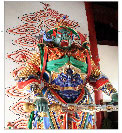James Baquet LEAVING Guangren Temple, my wife and I took a couple of local buses to the only other key temple located inside Xi’an’s city walls. Wolong Temple is a short walk from Xi’an’s main South Gate: east down the Xueyuan Road and past the Stele Forest Museum, near the Wenchang Gate. Said to be founded over 1,800 years ago in the Han Dynasty, it was called Fuying Temple in the Sui, and Guanyin Temple in the Tang, after a notable drawing of the Bodhisattva of Compassion was housed there. It wasn’t until the Song Dynasty that it acquired its current name. At that time, a monk of some renown named Weiguo dwelt in the temple. He called himself “Wolong,” or “Sleeping Dragon;” when people began to refer to the place by his name, it stuck. Once one of the leading monasteries of the city, it reached its peak in the Qing Dynasty, only to be largely destroyed in the Republican Period. Rebuilt on a more modest scale, it’s now a relatively sleepy place (compared to other attractions inside walls); we visited on two different summer days, once in the evening and again in the morning, and never had to fight crowds. One major attraction for me was watching workmen paint the 24 Deva Kings newly installed in the main hall. Many of these figures are from Indian tradition, including the gods Brahma and Indra. Although not exactly rare, a set like this is not all that common, and it was exciting to be there for a slice of history. A triad of Shakyamuni Buddha with two bodhisattvas had also recently been placed on the main altar.  | 
